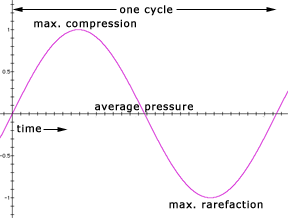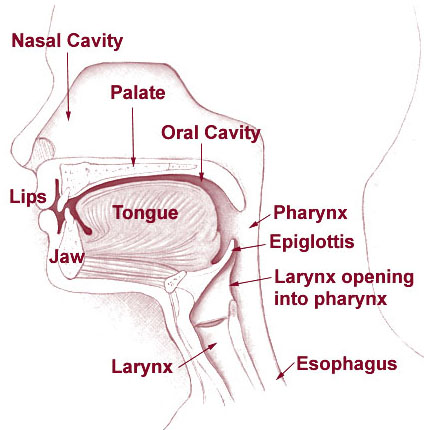What I’m going to try and do in this series of posts is follow my phonology module at Cardiff. As such, these posts are essentially my notes on the topic, and may not always come across too clearly. First, I thought it would be useful to give a quick definition of both phonology and phonetics, before moving on to discuss the anatomical organisation of our vocal organs.
Phonetics and Phonology
To begin, phonetics, often referred to as the science of speech sound, is concerned with the physical production, acoustic transmission and perception of human speech sounds (see: phone). One key element of phonetics is the use of transcription to provide a one-to-one mapping between phones and written symbols (something I’ll come back to in a later post). In contrast, phonology focuses on the systematic use of sound in language to encode meaning. So, whereas phonetics is specifically concerned with human speech sounds, phonology, despite having a grounding in phonetics, links in with other levels of language through abstract sound systems and gestures. SIL provides a useful little diagram showing where phonetics and phonology lie in relation to other linguistic disciplines:
I’ll get into the nitty gritty of these two areas in the next post. For now, all I want to get across is that there’s a difference between these two overlapping subjects. One last note before moving on: much of what I will cover in the rest of this post is more concerned with phonetics than phonology.
Vocal Organs, Sound and Voice
Probably the most important organ involved in language, and ironically the one I’m not going to discuss in this post, is the brain. After all, not only is the brain used to produce and comprehend aspects of language, it is also partially shaped by the socio-cultural environment in which it is embedded — a large portion of which involves being exposed to language. I’m going to also skip over our ability to hear sounds: clearly a highly relevant feature for most of us language-users (obviously not so relevant to those of us who use sign language), but the physics of causing particles of air to move and push against other particles of air, and how our ears are anatomically designed, is something I’ll come back to at a later point. With auditory phonetics and acoustic phonetics out the window, I’ll instead focus on the other sub-discipline of phonetics: articulatory phonetics.
Articulatory Phonetics
 Articulatory phonetics is primarily concerned with the airflow through the vocal tract. Specifically, it refers to how this vocal apparatus creates variation in air pressure, which in turn can be represented as sound waves that are then perceived by the human auditory system as sound. Phoneticians distinguish between two main types of sound sources within the articulatory system: periodic and aperiodic. A periodic sound follows a fairly predictable cyclical pattern (see right insert: sine wave). In language, a periodic sound is generally made at the glottis through vocal fold vibrations (although there are instances where periodic sounds are made using the tongue, as in alveolar trills). Vowels and voiced consonants are examples of periodic sounds. Conversely, aperiodic sounds are characterised through their non-repetitive patterns (see noisy sound below). The turbulent noise of fricative consonants are good examples of what phoneticians refer to as aperiodic sounds.
Articulatory phonetics is primarily concerned with the airflow through the vocal tract. Specifically, it refers to how this vocal apparatus creates variation in air pressure, which in turn can be represented as sound waves that are then perceived by the human auditory system as sound. Phoneticians distinguish between two main types of sound sources within the articulatory system: periodic and aperiodic. A periodic sound follows a fairly predictable cyclical pattern (see right insert: sine wave). In language, a periodic sound is generally made at the glottis through vocal fold vibrations (although there are instances where periodic sounds are made using the tongue, as in alveolar trills). Vowels and voiced consonants are examples of periodic sounds. Conversely, aperiodic sounds are characterised through their non-repetitive patterns (see noisy sound below). The turbulent noise of fricative consonants are good examples of what phoneticians refer to as aperiodic sounds.
Next, I shall look at the airstream mechanism. At its most basic all languages make different speech sounds by moving a column of air through part of the upper body and creating various kinds of vibration and noise as the air moves (Kreidler, 2004):
It is possible to use air that is drawn into the body from outside (try to say ‘Yes’ while inhaling). A more familiar way of using ingressive air for sound-production is to produce a click, such as the tongue-tip noise which we represent as tsk-tsk, or the clucking sound that is sometimes used in getting a horse to move. To produce such clicks we create a vacuum in the mouth, then open suddenly so that air rushes in. Another way of producing an air stream is to gather a quantity of air in the throat and then eject it all at once. In almost all of our speaking, however, we use a column of air which moves up from the lungs and out the mouth or the nose or both together, and we modify the air in its passage.
You may have noticed the term ingressive in the cited paragraph, which is simply a way of describing those sounds in which the airstream is coming inward through the mouth or nose. This is in contrast to egressive where sounds are created by pushing air through the mouth or nose. For the most part, I’ll be focusing on a particular type of egressive sound known as pulmonic egressive: sounds in which the air stream is created by the lungs, ribs and diaphragm. The vast majority of languages, including English, tend use sounds that are mostly pulmonic and egressive. The specific name for stop consonants using pulmonic egressive sounds is a plosive. For example, the /p/ sound in pig is an initial voiceless plosive, which is made through a strong release of air (aspirated). Other consonant sounds include glottalic egressive (egressive), glottalic ingressive (implosive) and velaric ingressive (clicks). I’m not going to get into the specifics of these until the third post in the series on consonants, so don’t worry if you’re feeling slightly overwhelmed by all these new technical terms. The important point to take away is that different combinations of air stream mechanisms will produce different types of speech sound.
Thus far, we have basically summarised speech as the following: a sound, or collection of sounds, made by an obstruction or near obstruction of the airflow. Below is a picture of most of the vocal organs. As you might’ve already noticed, one obvious absence is that of the lungs: these are crucial in that their expansion or contraction will determine when air is let in or let out. Air released from our lungs will travel up to the second notable exception: the trachea (also known as the windpipe). We now arrive at the larynx (see below): here, the primary vibration needed for speech is produced by the vocal cords. At the pharynx, located just above the larynx, the air stream can go up into either the oral cavity or the nasal cavity. In the diagram below, the soft palate or velum (just above the arrow for pharynx) will allow for air to pass through both the nose and mouth. Normally, the soft palate will be raised in speech, stopping air from escaping through the nasal cavity. Sounds such as /k/ and /g/ are examples of what we call velar consonants: when the tongue is in contact with the bottom side of the soft palate.
We are now at the ‘roof of the mouth’, technically known as the hard palate. The sound /j/ in yep is made by moving the tongue close to the hard palate. These are known as a palatal sounds. Between the hard palate and the tongue is the alveolar ridge. Sounds such as /t/, /d/ and /n/ are made through the tongue touching the ridge. As Roach (2009) notes, the tongue is “a very important articulator and it can be moved into many different places and different shapes”. Even though there are no clear cut physical divisions, we can divide the tongue into abstract parts: tip, blade, front, back and root. Lastly, we reach the teeth. In English, /θ/ and /ð/, found in the sounds at the start of thick and this respectively, are made with the tongue touching the front teeth. These are known as dental sounds.
Right, that’s a very, very basic introduction to articulatory phonetics. In the next post, I will briefly introduce the concepts of vowels and consonants, before moving on to a fuller treatment of short vowels, long vowels, dipthongs and tripthongs.
References
Collins, B and Mees, I.M (2008). Practical Phonetics and Phonology. Routledge.
Kreidler, C (2004). The Pronunciation of English. Second Edition. Oxford: Blackwell.
Roach, P (2009). English Phonetics and Phonology: A practical course. Fourth Edition. Cambridge: C.U.P.




Interesting that the SIL cline has pragmatics UP and phonetics DOWN. It reflects a cultural attitude that pragmatics is somehow more complex of a field of study, which may be true, but only because we don’t understand it as well.
I thought that that diagram was a representation of the order the brain processes things with regards to top down and bottom up models. I don’t think it’s anything to do with how complex phonetics is verses any other linguistic discipline.